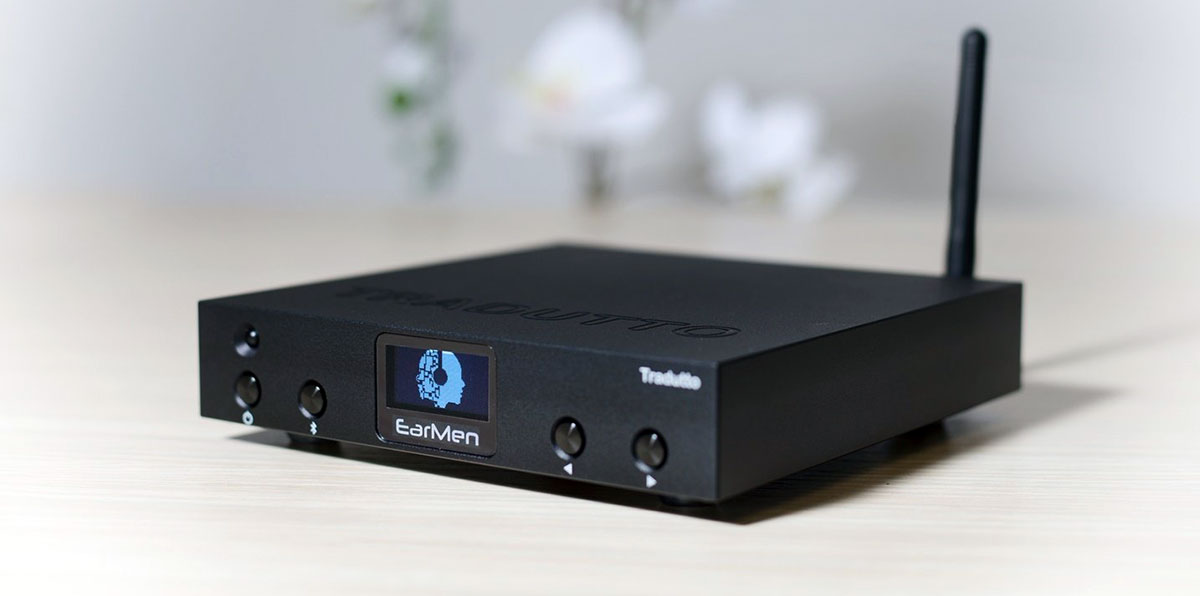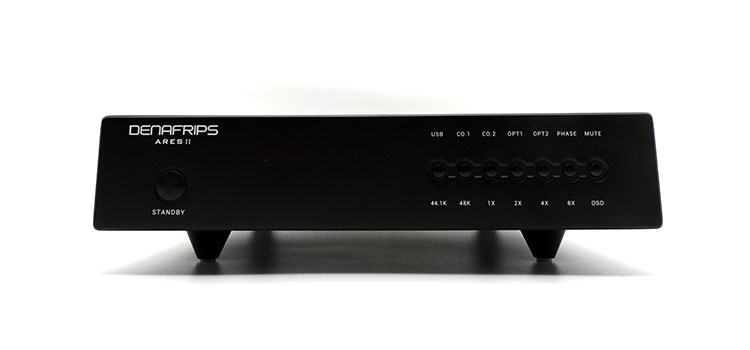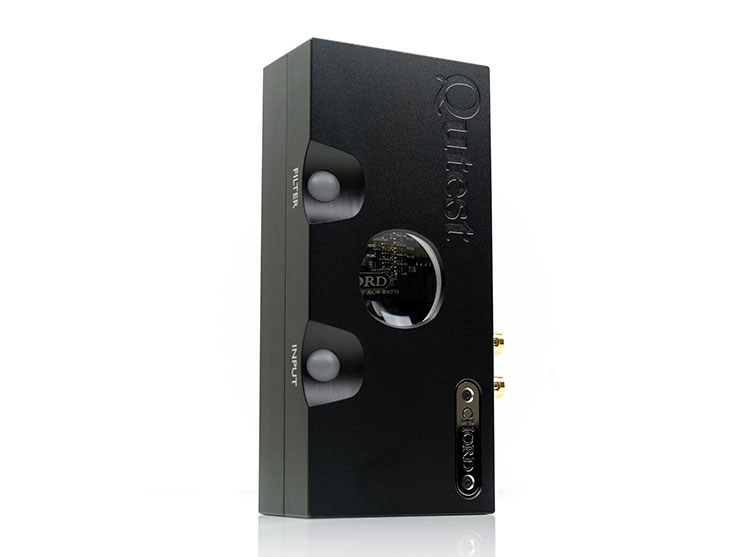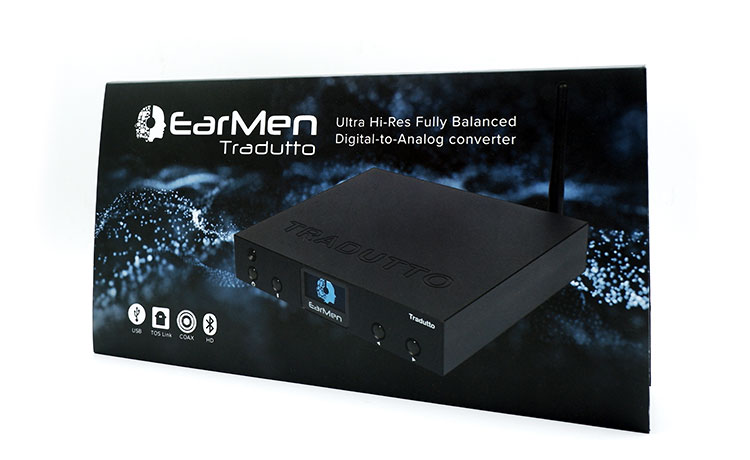Select Comparisons
Denafrips Ares II
$772.43
Technical
Both DACs are designed as pure DACs, and it may seem like the Ares II is a simpler device externally since it doesn’t have Bluetooth connectivity or remote functionality. However, the internals of the Ares II is more complicated having a discrete R2R architecture, which means that there are resistors inside the device that are switched on or off to produce a signal.
In terms of decoding capability, the Ares II can decode even higher sampling rates at 24BIT/1536kHz, and DSD1024. However, these sampling rates are yet to become widely available unless there is some upsampling involved.
A large portion of the Ares II’s hefty frame is occupied by the internal linear power supply, which means that the Ares II already has the best possible power supply by default. In contrast, the Tradutto’s wall wart SMPS can still be swapped out for a cleaner and more responsive power supply.
With R2R being inherently noisier than their delta-sigma counterparts, the Ares II only manages a THD+N of 0.004%, which is about 10x the amount of noise generated by typical delta-sigma DACs currently available in the market, including the Tradutto.
Design
Looking at the 2 DACs, the Ares II is much larger, but as mentioned earlier, it’s partly due to the linear power supply housed in the chassis, and of course, the discrete resistors that form its R2R ladder. While the black powder-coated finish of both DACs is similar, the Ares II’s chassis is much thinner since it’s made of sheet metal as opposed to being carved out of a piece of aluminum.
The front fascia on the Ares II is filled with buttons and LEDs instead of a screen. The LEDs are there to display the current input being used, as well as the current sampling rate being decoded by the DAC. Despite the lack of a screen, the Ares II has additional modes that can be accessed using a series of button presses.
At the rear, both devices have a similar set of inputs and outputs, where the Ares II has an extra coaxial and an extra optical input, while losing the Bluetooth aerial input.
For outputs, both DACs also have options for single-ended output and balanced output, however, the Ares II’s larger chassis allows it to have a full-sized 3-pin XLR output which is more common than a 4.4mm balanced pentaconn output.
Performance
With R2R DACs being one of the more fashionable DAC technologies in the audiophile community today, I was expecting the Ares II to flat out sound better. However, I was surprised that the 2 DACs end up trading blows in most aspects of their presentation.
Starting with the bass, both DACs extend well into the sub-bass region. When it comes to the mid-bass, the Ares II is more elevated while having a less controlled presentation. This results in the Ares II having a less immediate sense of attack and a less controlled response comparatively.
However, the most evident difference between the 2 DACs is when there are busier passages, as the Ares II is less capable of keeping up.
In terms of the vocal presentation, the Ares II is similarly planted, but there is a sense of euphony that truly makes it sweeter, calling more attention to itself. However, when it comes to ultimate detail retrieval, the Ares II is comparatively more glossed over.
Going into the upper registers, the Ares II can present some treble details but the edginess of the treble is not as chiseled. This makes the leading edges of cymbal hits less crisp, and the crunch of guitar strums less striking. However, the Ares II has a more elevated upper treble region allowing the airiness of instruments to be more apparent.
While the overall dimensions of the soundstage don’t change much, the Ares II creates a better-layered soundstage while the lateral placement of images is about the same. Also more apparent is the dynamic range capability of the Ares II, with a gentler touch for softer passages.
Chord Qutest
$1895
Technical
While the Qutest is technically still a delta-sigma DAC, it doesn’t use an off-the-shelf DAC chip from any other manufacturer like AKM, ESS, or Cirrus Logic.
Instead, the designer at Chord, Rob Watts created a DAC using an FPGA(Field Programmable Gate Array), which is programmed as a DAC and is then implemented with interpolation filters to smooth out the gaps between samples.
Inside the Qutest, it houses a Xilinx Atrix 7 FPGA chip and is programmed with a 49,152 tap filter. For reference, a typical off-the-shelf DAC will only have a tap filter that’s a few hundred taps long. This results in allowing the Qutest to have a very low THD of 0.0001%, cutting down the measured THD on the Tradutto by 1/3.
With both devices being designed as pure DACs, they have the typical input options with USB, Coaxial, and Toslink. However, the Qutest doesn’t have any wireless options, instead, it has an extra Coaxial input that can be used as another input or in dual BNC mode to run Chord’s upsampling Hugo M Scaler.
The outputs on the Qutest are more limited though since it only has a pair of single-ended outputs.
Decoding capabilities are pretty much the same on the 2 devices, with both capable of decoding 32bit/768kHz, and DSD512 while MQA is simply left out. However, the Qutest has 4 filter options that make subtle differences in the presentation.
Design
When looking at the 2 devices, they are strikingly different, with the Qutest being a more irregularly shaped device. Both devices are dense, but the Qutest feels denser between the 2, while the finish of both devices is comparable. When it comes to the footprint of the devices, the Qutest takes up a bit less space, but it’s a bit thicker.
The Qutest may seem a bit harder to use, and that’s expected since it has orbs and color codes that show input, sampling rate, filters, and voltage level. It would be much simpler to go with EarMen’s approach of using mostly text-based information.
Both devices also use a standard SMPS power supply, however, the one on the Qutest uses a 5v input instead of 12v. At the rear of both devices, the inputs are all laid out properly, however, the coaxial input on the Qutest uses a BNC connector which is less common than the standard RCA connectors that most DACs including the Tradutto use.
Performance
I initially thought that the Qutest has a much softer presentation, however, after long listening sessions, the Qutest is more nuanced with better contrast in its dynamic range producing a more natural presentation compared to the Tradutto.
The sub-bass region on both DACs is equally extended, but the Qutest has more impact. The Qutest may seem less forward in the mid-bass, but the immediate sense of attack is more apparent when it is called to do so.
When it comes to the textures and subtleties of presenting drums or bass guitars, both DACs present a nuanced presentation. However, the details are readily available on the Qutest while smoothing some of the edges making it equally detailed while being less fatiguing.
The Qutest doesn’t have as much heft but it can present the weight of the vocal performance accurately. The overall vocal presentation with the Qutest is much sweeter while being subtle enough to ensure that the resulting euphony doesn’t feel artificial.
Guitar tracks on the other hand have a less crisp character with the Qutest. So my attention is less drawn towards the guitar strums and plucks in acoustic tracks. With pianos, the Qutest also has a comparatively brighter tilt that allows for a sweeter presentation when it’s in the track.
Cymbal hits are less aggressive with the Qutest, but that also translates to having a less energetic presentation comparatively. Both DACs maintain a good amount of control so the shimmer of cymbals doesn’t become noisy.
With better dynamic contrast, the Qutest presents a more layered presentation allowing images to go deeper into the soundscape. The images created by both DACs are about equally accurate, however, when it comes to the delineation of the images within the soundstage, the Qutest isn’t as strikingly chiseled.

SMSL SU-9
$439.00
Technical
Hovering at around half the price, it’s surprising to see that both DACs have practically the same features and specifications. In fact, the SU-9 even has a leg up in terms of the DAC chip used, since it uses an ES9038 Pro instead of an ES9038 Q2M.
The USB controller on both DACs is the same XMOS XU216, so both DACs have the same 32BIT/768kHz, DSD512, and MQA decoding capability. When it comes to Bluetooth though, the SU-9 seems to have an older Bluetooth chip as it’s only capable of Bluetooth 5.0, but it has UAT decoding capabilities in addition to the more common SCB, AAC, and AptX/LL/HD.
While both DACs have balanced and single-ended outputs, the SU-9 has a more standard pair of 3-pin XLR balanced connections instead of a 4.4mm pentaconn connection. The THD numbers on the SU-9 are even lower at 0.00009%.
Although the SU-9 is designed to primarily be a DAC, it can also double as a pre-amp which can also be controlled using the included remote control. In addition to preamp functionality, the SU-9 also has DAC filters and sound color available for mildly tweaking the sound.
Design
The SU-9 is the larger of the 2 DACs, but it’s interesting to see that the SU-9 is lighter despite having an internal power supply.
The front of the 2 devices is also very different since the SU-9 has a larger 1.9” TFT screen that shows the same amount of information. Due to the busier colored screen, the SU-9 is a bit harder to see when looking at it from a distance.
To the left of the screen, there is a volume knob, and it also doubles as a menu navigation knob. In use, the SU-9 is harder to navigate partly due to more available options, but it’s also due to a deeper menu system as opposed to dedicated buttons for quick access to features. Both DACs also have remote controls, but the SU-9’s remote feels less premium despite having more functions.
On the rear of both devices, the available input options are arranged properly, but the SU-9 has an extra terminal for the Bluetooth aerial. With the larger footprint of the SU-9, it also accommodates a full-sized balanced 3-pin XLR connection and an IEC power inlet.
Performance
Both DACs reach deep down into the sub-bass while having a palpable mid-bass response. However, the attack and decay of drums on the SU-9 lingers for a moment longer, making it less natural comparatively.
Textures in the midbass are also less apparent with the SU-9, drum hits are more rounded and things like the size of the drum cavity as well as the type of stick being used is less apparent. This is partly due to the SU-9 having a thicker bass presentation.
When it comes to the presentation of the vocal range, the SU-9 is more forward, while having a more euphonic and sweeter presentation. However, the raspy vocal texture of singers such as Adele isn’t as apparent.
Midrange instruments on the other hand have a more full-bodied presentation on the SU-9. However, the leading edges of notes are less apparent on the SU-9, leading to a lack of crispness in guitar strums or the percussive quality of keystroke on a piano.
While the treble presentation is similarly forward, the crystalline quality of cymbal hits has less sparkle with the SU-9. Also, the decay of cymbal hits tends to linger a bit longer, leading to a splashier and less defined presentation.
Dynamic contrast isn’t the most apparent with either of these DACs, however, the SU-9’s thicker presentation makes it sound consistently louder. This makes the soundstage on the SU-9 have less depth and dimensionality. While both DACs maintain directionality well, the images formed with the SU-9 are not as separated.
Our Verdict
As a pure DAC that fits nicely on a desktop, the Tradutto makes for a versatile desktop control center that allows for the standard digital wired connections such as USB, coaxial, and Toslink while being equipped with a Bluetooth 5.1 receiver. Its aluminum chassis and anodized metal finish make it seem like a device that could last for quite a while.
With the current DAC market trending towards more exotic DAC architectures like R2R or multibit, EarMen went for a delta-sigma chip-based ESS DAC with the Tradutto. However, when it comes to how it sounds, there is nothing common about the Tradutto.
While it won’t be as textured as some R2R DACs, the Tradutto takes the detailed presentation of the ES9038Q2M and injects some excellent layering and dynamics through a careful design of both the power supply and the analog output stage.
EarMen Tradutto Specifications
Inputs
- BlueTooth QCC5124, Bluetooth 5.1™ ( AAC, SBC, aptX, aptX HD, aptX LL )
- USB, TOSLINK, S/PDIF optical Coax, S/PDIF
Outputs
- RCA (SE output) output impedance = 300Ω
- Balanced 4.4mm output impedance = 600Ω
Audio Formats
- PCM up to 768kHz
- DSD DoP64, DoP128, DoP256, native DSD512
- DXD up to 768kHz
- MQA OFS (MQB/MQA Core), MQA, MQA Studio
- Bluetooth 44.1kHz – 192kHz/16bit – 24bit
Single-end output
- USB input S/PDIF input/BT
- Output Level 2Vrms 0dBFS 2Vrms 0dBFS
- THD+N 0.0003% 0.0003%
- SNR >116dB >116dB
- A-Weighted A-Weighted
- Freq. Response ±0.014dB ±0.006dB
Fully Balanced Output
- USB input S/PDIF input/BT
- Output Level 4Vrms 0dBFS 4Vrms 0dBFS
- THD+N 0.0003% 0.0003%
- SNR >120B >122dB
- A-Weighted A-Weighted
- Freq. Response ±0.03dB ±0.003dB
Dimensions
- LxHxW 150x30x150 mm 5,9″x1,18″x5,9″
- Weight 550 gr 1,21lbs








